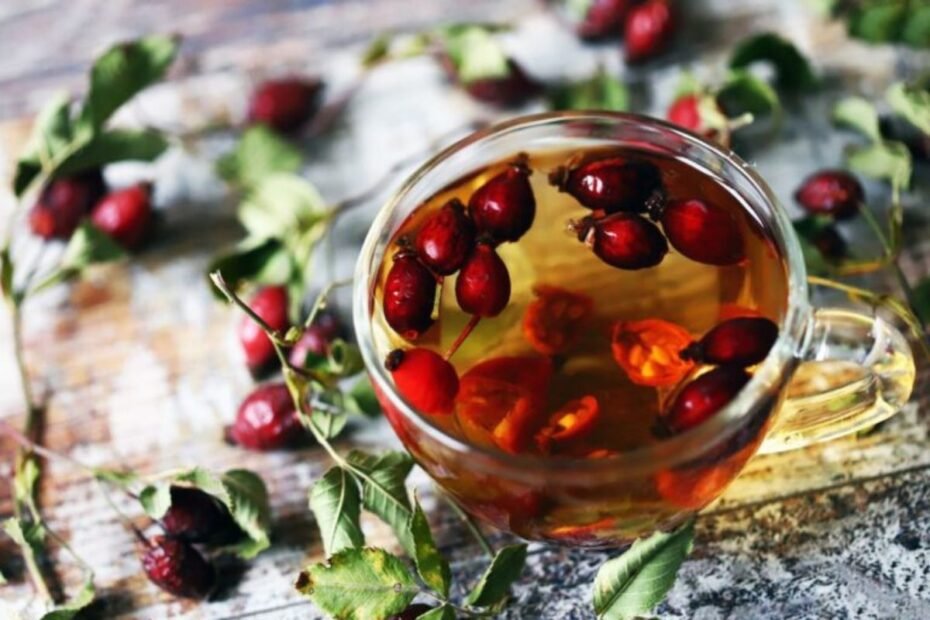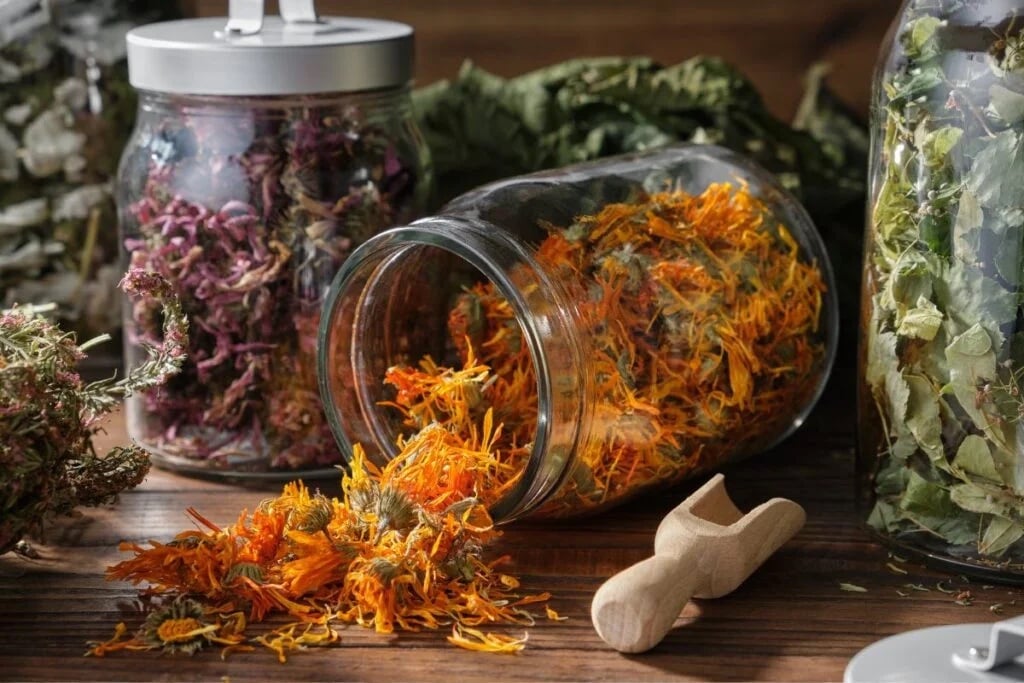When you think of hawthorn, one of the most common associations is the heart-calming drops. But hawthorn has many more varied benefits. People use hawthorn berries, leaves, and flowers for strengthening and healing. You can find hawthorn capsules, liquid extracts or tinctures, and hawthorn tea to buy. Let’s dig in and find more hawthorn tea benefits.
How Do I Identify the Hawthorn?
Hawthorn (Crataegus) is a member of the rose family (Rosaceae). It is a widespread plant in gardens and the wild—meadows, woodlands, and roadsides. There are about 200 species in the genus. It grows in North America, Europe, and Asia. Depending on the species, hawthorn can grow up to 3–5 m tall. The hawthorn usually resembles a woody shrub. You can distinguish these plants by their sharp spines covering the shoots.
The hawthorn leaves are small, fan-shaped, and somewhat reminiscent of the ginkgo but are more curled. It blooms in spring and early summer with numerous, usually white, five-petalled flowers. The flowers have a not-very-pleasant smell due to the organic compound trimethylamine.
The fruit depends on the species but may be round, oblong, or pear-shaped. The fruit ripens in August and September. When ripe, the fruit is red, orange, or yellow. The flavor and texture are somewhat reminiscent of rose hips. The seeds are similar to apples and are slightly toxic due to hydrocyanic acid.
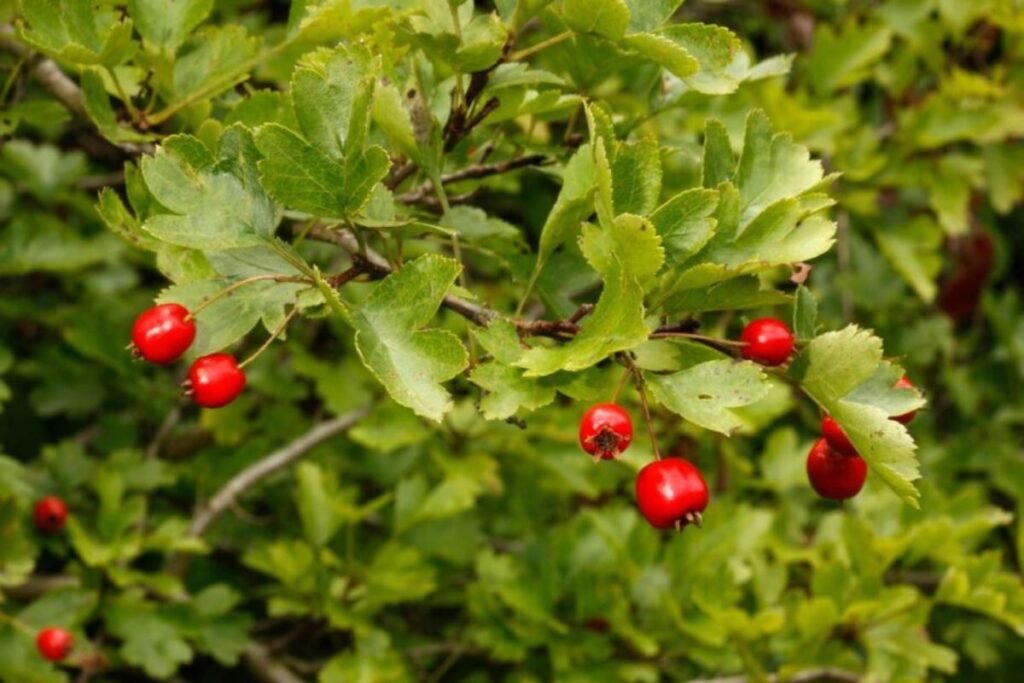
Hawthorn Raw Material: Collection and Preparation
Hawthorn leaves, flowers, and fruit are processed to make medicinal and fortifying teas and decoctions. You can gather and prepare herbal supplies from the garden or wild hawthorns. If you are collecting raw materials from wild lands, do not harvest near roads and streets.
- Harvest the leaves before the plant blooms, in about April or early May. At this time of year, the leaves are most nutritious and valuable. However, you can collect leaves later.
- Collect the flowers when they start to bloom, ideally in May. Harvesting the flowers, which are just opening, is also particularly useful.
- The berries are picked when ripe in August or September.
The harvested medicinal raw material is dried in a warm, dry place protected from direct sunlight. You can dry the fruits of the hawthorn in the same way as other fruits or berries, for example, in a drying rack or the oven. You can also frozen them, giving you fresh produce all winter.
It is advisable to store dried hawthorn raw material in a paper or natural fabric bag in a dark, dry, and well-ventilated place. You should consume it within two years.
If you cannot prepare hawthorn raw material, you can purchase it in pharmacies or other outlets.
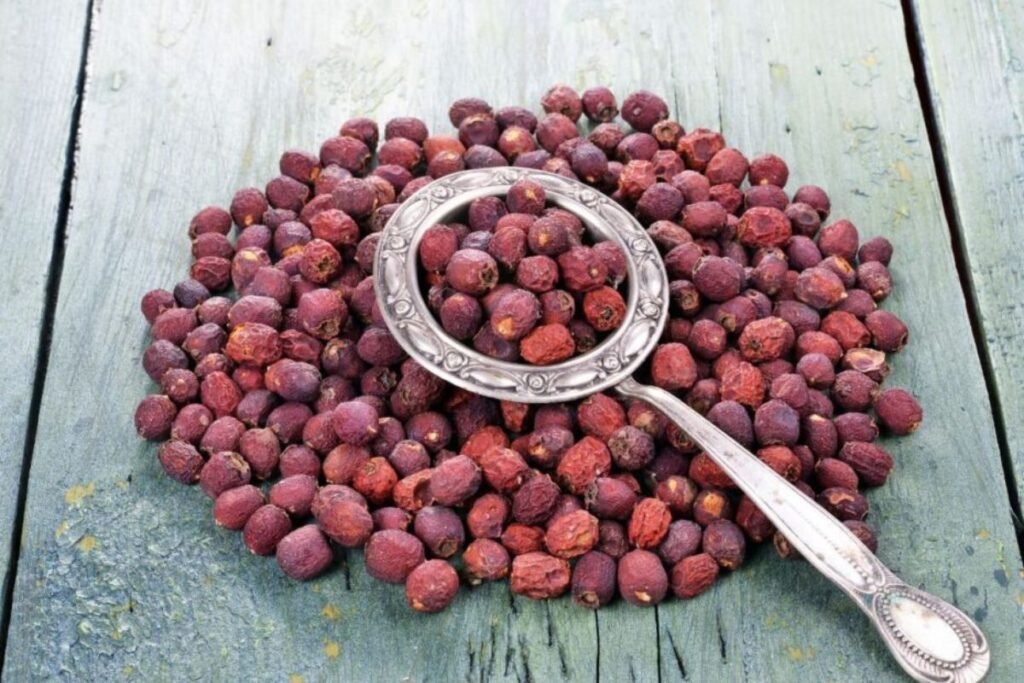
Hawthorn Tea Benefits
In traditional Oriental medicine, hawthorn berries have been used as one of the main herbs since at least the 7th century. Hawthorn has been used to treat three main ailments: digestive disorders, heart disease, and high blood pressure.
Modern medicine also acknowledges many of hawthorn’s healing properties, but its effect on some diseases is still under investigation. Taking hawthorn tea can strengthen the body and prevent and treat dangerous diseases.
- Hawthorn tea is rich in antioxidants, which protect the body from free radical damage that can lead to chronic diseases, including cancer. Antioxidants are also essential for boosting immunity.
- Hawthorn tea (and other preparations) is a natural remedy to prevent and treat heart disease. Hawthorn can help with angina pectoris, mild heart failure, and hypertension. However, there is conflicting information on the effects of hawthorn on people with moderate to severe heart failure. In this situation, the use of hawthorn should be consulted with the advice of a doctor.
- Hawthorn has a vasodilating effect. It helps to lower cholesterol levels. Hawthorn berries have anti-inflammatory properties.
- Hawthorn tea is used to treat digestive disorders. It is particularly recommended for stomach pain. The berries contain fiber, which helps digestion, reduces constipation, and acts as a probiotic.
- Preliminary research findings suggest that hawthorn may act as a sedative. Because of this property, hawthorn tea can be used to alleviate symptoms of anxiety disorders and depression.
- Hawthorn tea improves blood circulation and may delay the aging of the skin.
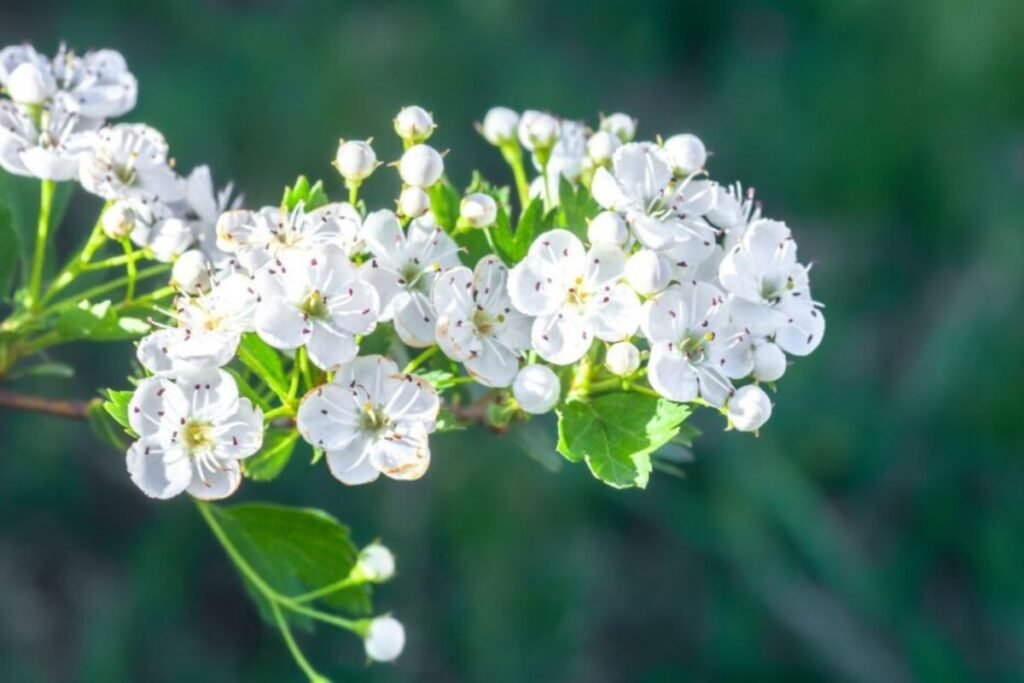
How to Prepare Hawthorn Tea?
To make hawthorn tea, brew 1-2 teaspoons of dried hawthorn leaves, flowers, or berries in boiling water and steep for 5–10 minutes.
The more hawthorn material you use, or the longer you steep it, the richer the tea concentrate you get. It is recommended to dilute the concentrate with water before drinking.
If you prefer, you can sweeten the tea with honey.
Hawthorn tea has a positive effect on your body if you drink it regularly.
Hawthorn Berry Tea Benefits and Preparation
The taste of hawthorn berry tea is described as ‘pleasantly spicy,’ but this can vary depending on the preparation and the hawthorn raw material.
Hawthorn berry tea is more often made from dried berries. Tea made from fresh berries usually has a less pronounced flavor.
For the tea, you will need:
- 2 tablespoons of dried hawthorn berries,
- 2 cups of boiled water.
You can prepare hawthorn berry tea in two ways:
- Place the dried hawthorn berries in a tea-making bowl. Pour boiled, just-cooled water over the hawthorn, cover, and leave to steep, preferably for a few hours or overnight. Strain, warm slightly before drinking, and enjoy.
- Add the dried hawthorn berries to a pot and cover with water. Bring the pot to a boil, reduce the heat, and simmer for about 20 minutes. Turn off the heat and leave the decoction to stand for a few more hours. Strain, warm slightly before drinking, and enjoy.
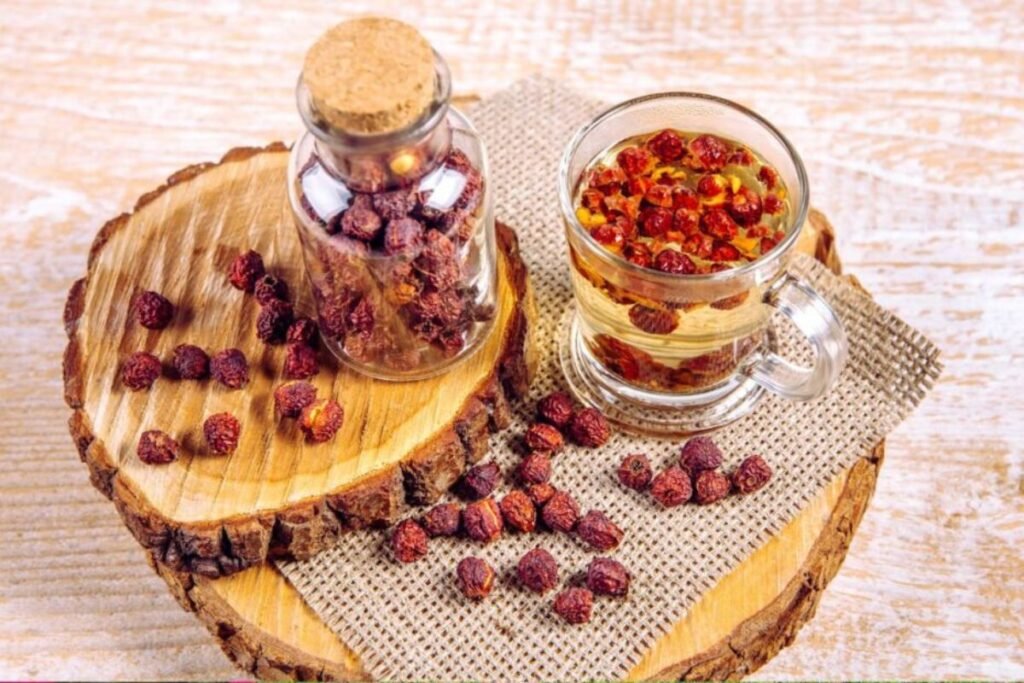
Cold Hawthorn Tea
You probably haven’t tasted iced hawthorn tea. It is a delightful refreshing drink with a distinctive, savoury fruity flavour! This tea is simple to prepare, has a thirst-quenching effect, and suits well with any dish.
For the tea, you will need:
- a couple tablespoons of dried hawthorn berries,
- sugar (to taste),
- water (as much as to make a tea).
Place the dried hawthorn berries in a medium saucepan and cover with water. Bring everything to a boil, reduce the heat, and simmer for 45 minutes. When the decoction gains a rich amber color, turn off the heat. Then put in the sugar and whisk until dissolved. Allow the tea to cool completely. Place ice cubes in glasses and filter the tea through a strainer. If the tea is too pungent and spicy for your taste, let’s add more honey.
Hawthorn Fruits in The Diet
You can get positive health benefits by including hawthorn fruit or products containing it in your diet.
Fresh hawthorn berries have a spicy, slightly sweet taste. They can be a delicious snack on the go or at work. It is best not to eat hawthorn seeds, as they contain the toxin cyanide, just like apple seeds.
Hawthorn berries can be used to:
- make jam, marmalade, and syrup, either from hawthorn berries or in combination with other berries.
- as a filling for various baked goods.
- added to sauces, porridge, salads, etc.
- make flavorful vinegar to flavor salads.
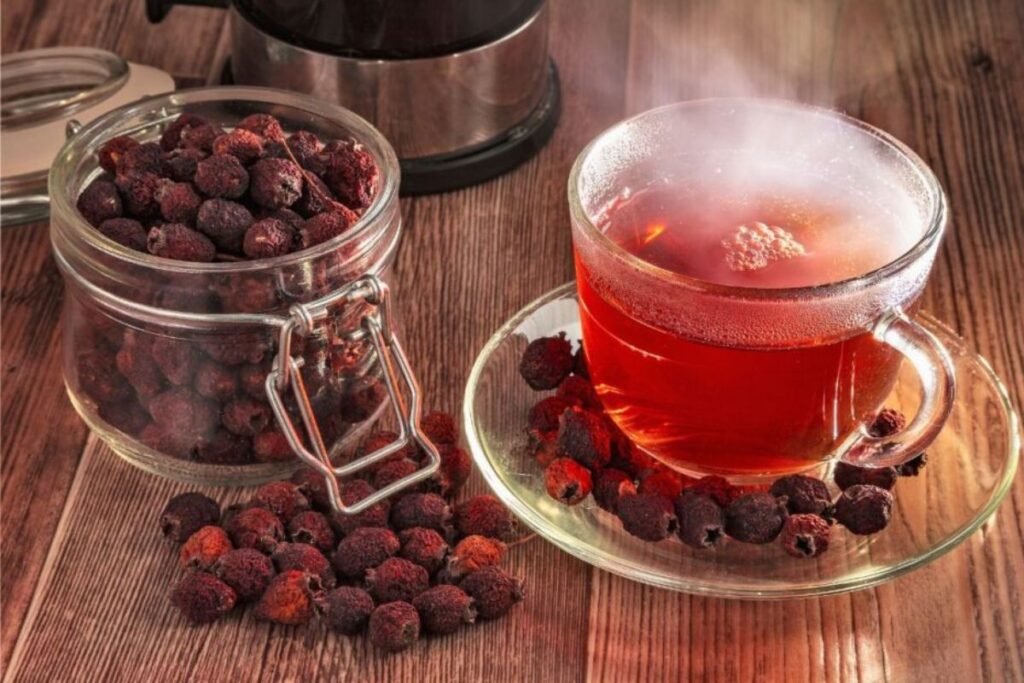
Hawthorn Tea Benefits for Hair Strengthening
The natural chemicals (minerals, vitamins, and antioxidants) in hawthorn benefit the whole body. External beauty is no exception. Hawthorn tea can be an effective treatment for hair loss. It is simple to try this remedy, and the effect can be beyond expectations.
Prepare a concentrated infusion of raw hawthorn tea (preferably dried leaves and/or flowers). You can enrich the tea with aloe vera, nettle, and burdock. Apply the chilled tea infusion to the hair, cover it with a natural towel, and leave it on for about 3 hours. Then rinse your hair.
The first time you use the treatment, keep your towel-covered hair shorter and monitor any adverse reactions. If you experience any discomfort, immediately rinse your hair.
Side Effects of Hawthorn Tea
Hawthorn is considered to be a safe herb. Side effects are rare and mild to moderate. Adverse effects may include sweating, headaches, drowsiness, a strong heartbeat, a mild rash, anxiety, and gastrointestinal upset.
However, in some cases, hawthorn may provoke more health problems. Do not consume hawthorn or consult your doctor first if you:
- You are pregnant or breastfeeding.
- If you are allergic to rose family plants or have other allergies.
- You are taking blood thinners.
- If you have moderate or severe heart failure and are taking medicines for it.
- You have a heart arrhythmia.
Sources:
- https://www.healthline.com/nutrition/hawthorn-berry-benefits
- https://healthiersteps.com/hawthorn-tea-benefits-that-will-improve-your-health/
- https://www.healthygreensavvy.com/hawthorn-berry-tea-recipe/
- https://thewoksoflife.com/hawthorn-iced-tea/
- https://www.urmc.rochester.edu/encyclopedia/content.aspx?contenttypeid=19&contentid=Hawthorn
- https://realselfsufficiency.com/foraging-101-how-to-identify-and-harvest-hawthorn/
Associative photos from © Canva.
